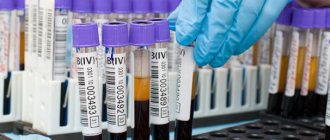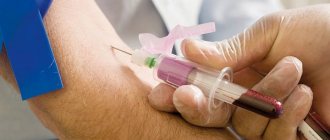May 26, 2020
For patients over 40 years of age, cancer prevention becomes a mandatory procedure. An important tumor indicator is prostate-specific antigen. The protein is produced by the cells of the male gland, its quantity allows us to judge health. What is PSA, what is its norm and how to get tested correctly, specialists from Dr. will tell you. AkNer.
Why is this informative?
The medical definition of PSA indicates that normally the bulk of this protein substance is located in the ducts of the gland. Its task is to provide the desired consistency of the seminal fluid and promote its liquefaction. In healthy men, a small portion of the protein passes from the ductal system into the blood vessels and then into the blood. It is this parameter that is monitored during screening.
An increase in the indicator occurs in response to certain changes in the body. With the development of pathology, the barrier between the blood vessels and the ducts of the gland is broken, which causes massive penetration of protein into the blood.
What is prostate-specific antigen?
Prostate-specific antigen (PSA) is a protein produced by prostate cells.
Biochemically, prostate-specific antigen belongs to the kallikrein protease family and is known as human kallikrein-3 (HK-3). Prostate-specific antigen, entering the sperm, liquefies it and thereby increases sperm motility necessary for fertilization. Most of the prostate-specific antigen enters the semen and only a very small part enters the blood, which is why the unit of measurement used is nanograms per milliliter (ng/ml). If your PSA level is high for your age and continues to rise, a prostate biopsy (collecting cells and tissue for diagnosis) may be recommended. Before recommending a biopsy, your doctor should consider other risk factors for prostate cancer, such as family history and ethnicity. A biopsy is the only way to determine whether there is prostate cancer or other abnormal cells in the prostate gland.
How is PSA measured?
PSA is measured using a blood test. Since the amount of PSA in the blood is very low, very sensitive analysis technologies (monoclonal antibody procedure) are required to detect it. PSA protein can exist in the blood in an unbound form (free PSA) or can be associated with other substances (bound PSA). The total PSA level is the sum of the free and bound forms and is measured using a standard PSA test.
What causes an increase in PSA levels in the blood?
It is believed that an increase in PSA in the blood is associated with its release into circulation due to a violation of the structure of the prostate gland. This can occur in the setting of various prostate diseases, including prostate cancer. It is important to note that PSA is not specific for prostate cancer , but an increase in PSA may indicate the presence of some kind of prostate disease. The most common causes of elevated PSA are benign prostatic hyperplasia (enlargement of the prostate gland) and prostatitis (inflammation of the prostate gland). However, an increase in PSA can also occur as a result of other reasons, such as ejaculation, transrectal ultrasound (TRUS) of the prostate, cystoscopy and bladder catheterization with a soft catheter, and prostate biopsy. Therefore, men who decide to undergo PSA testing should be aware of these important factors that may affect the results. Age and prostate volume can also affect PSA test results.
What are normal PSA test results?
There are no specific normal or abnormal levels of PSA in the blood. Younger men have lower levels and older men have higher levels. In the past, most doctors considered a PSA level below 4.0 ng/mL to be normal. Therefore, if a man had a PSA level above 4.0 ng/ml, doctors often recommended a prostate biopsy to determine prostate cancer.
However, more recent studies have shown that some men with PSA levels below 4.0 ng/ml may have prostate cancer, while others with higher levels may not. In addition, it is important to keep in mind that various factors can cause PSA levels to fluctuate. For example, a man's PSA level often increases if he has prostatitis or a urinary tract infection. Prostate biopsy and prostate cancer surgery can also increase PSA levels. Conversely, some drugs, including finasteride and dutasteride, which are used to treat benign prostatic hyperplasia (BPH), lower PSA levels.
PSA levels also vary by ethnicity and family history of prostate cancer. It may also vary slightly when tested in different laboratories. Although expert opinion varies, there is no clear consensus on the optimal PSA threshold for recommending prostate biopsy for men of any racial or ethnic group.
In general, however, the higher a man's PSA level, the more likely he is to have prostate cancer. Additionally, a continuous increase in a person's PSA level over time can also be a sign of prostate cancer. The annual rise in PSA (known as the PSA rise rate) plays a role in the PSA marker decision.
What are the age ranges for PSA?
The use of age-specific PSA ranges to detect prostate cancer is controversial. Not all researchers agree that this is better than simply accepting a PSA level of 4.0 ng/mL as the upper normal value. However, due to age-related prostate growth, the concept of adjusting PSA values according to age has helped reduce unnecessary prostate biopsies in older men to improve early detection of prostate cancer. The following are age-adjusted upper limits for total PSA:
- 40-49 years old - 2.5 ng/ml;
- 50-59 years old - 3.5 ng/ml;
- 60-69 years old - 4.5 ng/ml;
- 70 years or more - 6.5 ng/ml.
What to do if the screening test shows an elevated PSA level?
If a man who has no symptoms of prostate cancer decides to undergo prostate cancer screening and is found to have a high PSA level, his doctor may recommend a secondary PSA test. If your PSA level is still high, your doctor may recommend continuing PSA tests and digital rectal examination (DRE) at regular intervals to monitor any changes over time. If your PSA level continues to rise or if there is any suspicion during a DRE, your doctor may recommend additional tests to determine the nature of the problem. A urine test may be recommended to check for a urinary tract infection. Transrectal ultrasound, x-ray or cystoscopy may also be recommended.
If prostate cancer is suspected, your doctor may recommend a prostate biopsy. During this procedure, several samples of prostate tissue are taken by inserting a hollow needle into the prostate. Most often, needles are inserted through the wall of the rectum (transrectal biopsy), but needles may be inserted through the skin between the scrotum and anus (transperineal biopsy). A pathologist then analyzes the collected tissue under a microscope. The doctor may use ultrasound during the biopsy. However, ultrasound alone cannot be used to diagnose prostate cancer.
How is PSA used for early detection of prostate cancer?
Clinically localized prostate cancer generally does not cause any clinical symptoms. Men generally do well and a prostate biopsy to detect prostate cancer is usually initiated when there is an abnormal digital rectal examination of the prostate and/or an abnormal PSA value. Thus, in clinical practice, tests to detect prostate cancer include serum PSA level measurement, digital rectal examination, and transrectal ultrasound (TRUS).
PSA level is an independent variable for predicting the presence of prostate cancer. In fact, the higher the level, the higher the likelihood of prostate cancer. An abnormal result usually requires additional testing. However, the definitive diagnosis of prostate cancer depends on the presence of cancer cells found in prostate biopsies or surgical specimens.
Typically, a PSA level greater than 4.0 ng/ml is considered suspicious. As levels increase above 10.0 ng/ml, the likelihood of cancer increases dramatically. However, not all men with prostate cancer have elevated PSA levels. It is known that cases of prostate cancer can also occur when PSA levels are less than 4.0 ng/ml. This is why doctors may use lower thresholds to decide when to do a biopsy.
For the average man over 50 years of age on digital rectal examination, the average probability of having prostate cancer (PCa) detected on prostate biopsy according to PSA level is as follows:
| Probability of biopsy-detected prostate cancer according to PSA level | ||||
| PSA level, ng/ml | 0-2,0 | 2,0-4,0 | 4,0-10,0 | More than 10.0 |
| Probability of prostate cancer on biopsy, % | 10% | 25% | 17-32% | 43-65% |
To improve the specificity of the PSA test in the early diagnosis of prostate cancer, several modifications of serum PSA are used, including the free/total PSA ratio and measuring changes in PSA levels over time. Because the likelihood of prostate cancer increases proportionally with PSA levels , there is no threshold below which a man can be confident that prostate cancer does not exist.
What is free PSA?
Most of the PSA protein released into the blood binds to other blood proteins. PSA that is not bound is known as free PSA and can be measured. Free PSA levels have been found to decrease in men with prostate cancer compared to those with benign lesions. The exact level depends on what test the laboratory uses, but generally a test result of less than 10% free PSA is suggestive of prostate cancer. This test is most useful when PSA test levels are between 4.0 and 10.0 ng/mL.
What is the free/total PSA ratio?
Prostate cancer cells, unlike soft prostate tissue, no longer produce PSA. Therefore, men with prostate cancer have a higher proportion of bound PSA in their serum and a lower percentage of total free PSA compared to men without prostate cancer. Thus, the free/total PSA ratio can be used in clinical practice to distinguish between PSA increases in benign disease and prostate cancer. This is especially useful for patients with a total PSA level between 4.0 and 10.0 ng/mL and a negative rectal examination to help the physician decide whether a prostate biopsy is necessary.
In one study, prostate cancer was found in 56% of men with a free/total PSA ratio of less than 0.10, but in only 8% of men with a free/total PSA ratio of more than 0.25. However, the concept of free PSA should be used with caution, as some factors, such as temperature and prostate size, may influence the free/total PSA ratio. In addition, measurement of free PSA is not clinically useful in patients with a serum total PSA value less than 10.0 ng/mL.
What is PSA rate of increase and PSA doubling time?
Changes in PSA levels over time can be used to assess both the risk of developing cancer and the aggressiveness of a particular tumor. PSA increase is defined as the absolute annual increase in serum PSA (ng/ml/year).
PSA doubling time is defined as the exponential increase in PSA over time and indicates relative change. These two measures may have prognostic value in patients being treated for prostate cancer. However, studies have shown that using these PSA measures to diagnose prostate cancer does not provide additional information compared to PSA levels alone.
How is PSA used to diagnose prostate cancer?
Once prostate cancer is diagnosed by the presence of cancer cells in a prostate biopsy, PSA is used to make the diagnosis. The staging is used to determine appropriate cancer treatment.
Serum PSA levels correlate with the risk of prostate cancer spreading beyond the prostate gland, including tumor invasion into the seminal vesicles and lymph nodes. The proportion of men with cancer limited to the prostate is approximately:
- 80% when the PSA level at diagnosis is less than 4.0 ng/ml;
- 70% for PSA levels between 4.0 and 10.0 ng/ml;
- 50% if PSA level is more than 10.0 ng/ml.
This is why patients with a PSA level of less than 10.0 ng/mL respond well to local therapy such as prostatectomy (surgical removal of the prostate gland) or radiation therapy. Over the past few decades, several prediction tools (otherwise known as nomograms) have included PSA in their parameters to predict post-treatment outcomes. These nomograms include the Partin and Kattan nomograms. For example, Kattan nomograms are a web-based smart tool that is available to the public.
How is the PSA test used after treatment for prostate cancer?
Periodic PSA testing is used to detect relapse of disease after treatment. PSA levels should decrease and remain at undetectable levels after local treatment such as radical prostatectomy. An increase in PSA after initial therapy indicates recurrence of prostate cancer. For example, if the prostate gland is surgically removed and all the cancer cells contained in the gland are removed, then the PSA level should drop to zero. In addition, PSA levels should decrease after radiation therapy, high-intensity ultrasound, and cryotherapy.
If, on subsequent testing, the PSA test is positive and shows an increase in the level, this means that not all cancerous tissue was successfully removed. Additionally, depending on the rise in PSA levels, it is possible that the cancer has now spread beyond the prostate gland.
What are the limitations of the PSA test?
The PSA level is a continuous parameter; the higher the value, the higher the likelihood of having prostate cancer. On the other hand, men can have prostate cancer despite low PSA levels. In a recent US study, 6.6% of men with PSA levels less than 0.5 ng/ml were diagnosed with prostate cancer. This is why there is no generally accepted level at which we can be sure there is no prostate cancer. Combined with the lack of accurate molecular markers to detect prostate cancer, another controversy with PSA screening is the fact that not all men with prostate cancer die from the disease.
For the reasons outlined above, it is important not to rely solely on a PSA blood test. The most useful additional test is a physical examination of the prostate by a doctor, known as a digital rectal examination (DRE). These studies show that the combination of PSA and DRE improves the overall detection rate of prostate cancer. For this reason, men who would like to be screened for prostate cancer should undergo a PSA test and a digital rectal examination (DRE).
What is a digital rectal examination (DRE)?
Most prostate cancers are located in the peripheral zone of the gland and can be detected using DRE. During this test, the doctor inserts a finger into the rectum to feel swelling, lumps, size, shape and hardness through the walls of the rectum. Suspicions raised during DRE are absolute indications for prostate biopsy. Approximately 18% of patients with abnormal DRE results were found to have prostate cancer, regardless of PSA level.
How can PSA be used for early diagnosis of prostate cancer?
Ultimately, the decision to use PSA for early diagnosis of prostate cancer must be individualized. Men should be informed of the known risks and potential benefits of early screening.
If prostate cancer is found on a prostate biopsy, all treatment options should be discussed. The benefits and risks of many prostate cancer treatment options should be considered and discussed with patients.
The discussion includes active surveillance, since some types of prostate cancer do not require immediate treatment. The goal of active surveillance is to help men maintain their quality of life when the disease is slowly growing or inactive. Other new biomarkers, such as the urinary prostate cancer gene 3 (PCA3), may help doctors make such decisions.
When is diagnosis relevant?
There are PSA standards for men by age. The analysis is prescribed during a routine examination:
- over 40 years of age if they are at high risk of developing prostate cancer;
- over 45 years old, average risk of cancer;
- over 50 years of age, in the absence of risk factors.
In addition, the reasons for ordering an analysis are:
- patient complaints of frequent, difficult or painful urination;
- changes in the size and consistency of the gland, identified by ultrasound or digital examination;
- history of elevated PSA values (more than 2.5 ng/ml);
- associated risks of cancer;
- prostate cancer therapy;
- control of cancer relapse.
The PSA test is very popular because it is informative, reliable, and the procedure does not cause discomfort to the patient.
Lowering values
A reduced level of a specific antigen does not indicate a deviation, but a minimal level of risk of developing malignant neoplasms. When examined over time, a decrease in total PSA less than 2 ng/ml indicates the effectiveness of treatment measures and a favorable prognosis.
In obese men, total PSA levels may be reduced due to an increase in the estradiol to testosterone ratio and hemodilution (a decrease in the number of red blood cells in the plasma associated with an increase in total plasma volume).
Preliminary preparation
When answering the question, PSA analysis, what is it, you should know the regulations for its implementation. For the test, venous blood is taken. There are two types of tests: total and free antigen. The first is standard and is prescribed more often, the second is used to clarify the diagnosis.
The analysis requires preliminary preparation. To exclude a false positive result, you must follow the following recommendations from doctors:
- blood is donated no earlier than two weeks after medical manipulations in the genitourinary system and pelvic area;
- before the procedure, avoid ejaculation for 3 days;
- you must stop riding a bicycle or horse three days before the procedure;
- Blood sampling is carried out on an empty stomach.
What can give false results
Erroneous results can be obtained for various reasons. In more detail, the following factors play a role.
- Cystoscopy. Endoscopy of the bladder. As a result of stimulation of the urethra and hollow organ, the prostate gland itself is irritated, resulting in an increase in PSA concentration. As a result, the doctor may draw incorrect conclusions.
- Performed prostate massage. It works in much the same way. The smooth muscles of the organ contract. A specific secretion is observed.
The result is an excess of the substance in the bloodstream. To avoid this, first an analysis is carried out, then a massage is prescribed. Not the other way around.
- Sexual activity the day before. Causes approximately the same processes as artificial massage. It is advisable to postpone sexual intercourse until the test is taken.
- Use of a number of medications. Methotrexate, antibiotics, anti-inflammatory, uricosuric drugs. There are even more options, only the main ones are named.
Before taking the test, you need to warn specialists about the treatment. This will help doctors know that false results are possible.
It’s even better to stop therapy for a while, but such issues cannot be resolved on their own. It's worth seeing a doctor.
- Infections of the urinary tract almost always cause false interpretation results. First, it is necessary to treat the underlying pathological process. Only then is a specific examination prescribed.
- Intense physical activity. Especially running, lifting weights, cycling. In order not to provoke false results, all this must be abandoned. For a while.
- All manipulations on the prostate gland. Iatrogenic, that is, medical factor.
All these points need to be corrected. Only a week after this can the examination be carried out.
What to do if the indicators are elevated?
Many men are concerned about what a higher than normal PSA means. It is important to remember that a large amount of antigen does not necessarily indicate an oncological process in the body. The analysis is a stage of complex diagnostics, and its results must be interpreted by a doctor.
In addition to prostate cancer, an increase in PSA levels is caused by:
- inflammation of the male gland;
- infarction or ischemia of the prostate;
- impotence;
- urinary tract infection;
- urinary retention;
- ejaculation on the eve of the study;
- adenoma (benign hyperplasia of the gland);
- violation of the rules for preparing for analysis.
Indicators that are determined
To assess the state of men's health, diagnostics are prescribed, including tests for the level of:
- General PSA;
- free PSA;
- percentage of free to total;
- 2-pro-PSA;
- Prostate Health Index - PHI.
The study is prescribed as a preventive measure for patients with a history of inflammatory and sexually transmitted pathologies. A comprehensive study allows you to diagnose prostate cancer or prostate adenoma at different stages.
PSA and oncology
What the PSA tumor marker shows is interpreted by the doctor in each specific case. According to medical statistics, almost 80% of cases of cancer changes in the prostate gland are accompanied by an increase in this protein. However, its high values may indicate other pathologies, so do not worry in advance. To clarify the diagnosis and exclude oncological degeneration, the doctor will prescribe a transrectal biopsy of the prostate under ultrasound guidance. Histological examination will reliably show whether there are changes in the tissues of the gland.
An increase in PSA is a reason to seek help. Experienced urologists and andrologists at the Dr. AkNer will help to identify pathology in a timely manner and prescribe adequate therapy.
Urologist, andrologist Akopyan Nerses Grigorievich.
Back to list of articles
Specific protein
This is a substance that is produced exclusively by prostate tissue. Determined if organic lesions of the prostate are suspected - benign or malignant. An increase in PSA is observed during:
- prostatitis;
- infectious organ lesions;
- hyperplasia;
- malignant neoplasm.
According to statistics, among patients whose PSA value is in the range of 4-10 ng/ml, the biopsy detected malignant cells in only 25%.
The ratio of free to total PSA in prostate adenoma is usually higher than in cancer. But to confirm any of the diagnoses, additional diagnostic methods are needed.
Actions to take when raising a dog's level
An increased dog standard does not always indicate the presence of cancer, but to completely exclude it, it is better to undergo additional examination:
- repeating the dog test;
- general blood analysis;
- sperm culture;
- palpation (rectally);
- Ultrasound of the prostate gland (transrectal);
- biopsy of prostate tissue.
Only by repeating some examinations can you confirm the diagnosis and undertake the only correct treatment. This is also necessary in order to reassure the patient if the dog is taller than normal, because many men panic after the test results are announced.
Important! All men over forty-five years old should have their PSA blood tested annually and visit a urologist.








